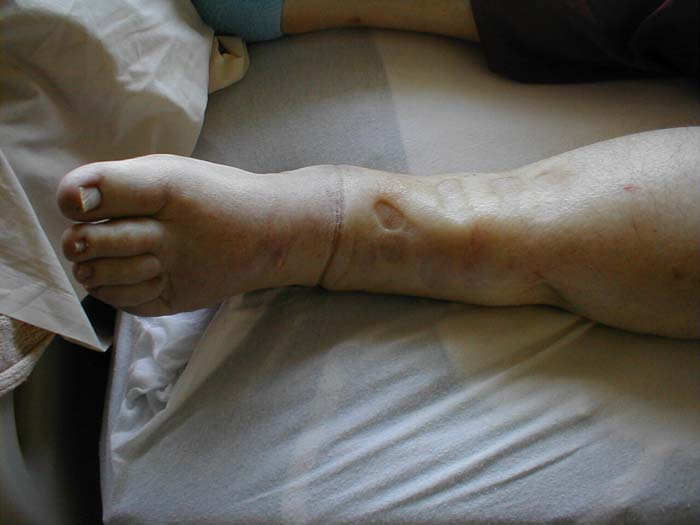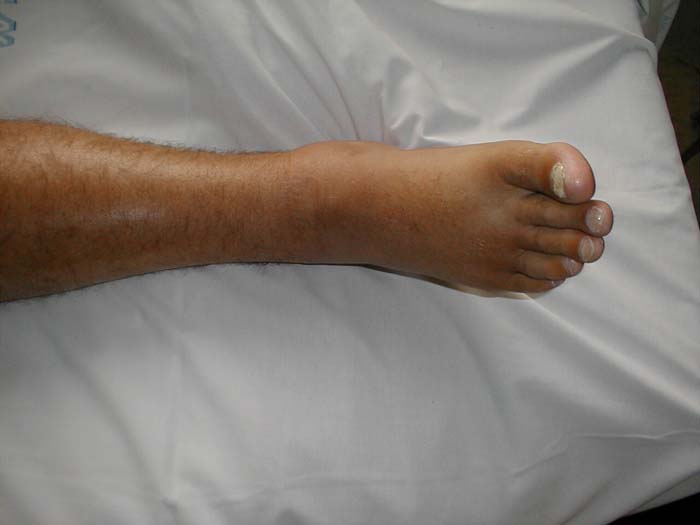Pedal edema: Difference between revisions
| Line 12: | Line 12: | ||
==Overview== | ==Overview== | ||
Competent venous valves, intermittent leg muscle contraction and respiration is required to support normal venous blood return. When these fail, [[venous insufficiency]] and edema occur. Edema can occur in 2 forms: pitting and non-pitting. Pitting occurs when there is fluid movement when pressure is applied. Non-pitting is swelling of the tissue itself, not an excess of fluid surrounding the tissue. | Competent venous valves, intermittent leg muscle contraction and respiration is required to support normal venous blood return. When these fail, [[venous insufficiency]] and edema occur. [[Edema]] is caused by an accumulation of an excessive amount of watery fluid in the serous cavities, tissues or cells causing painless, non-reddened swelling. | ||
==Classification== | |||
Edema can occur in 2 forms: pitting and non-pitting. | |||
===Pitting Edema=== | |||
Pitting occurs when there is fluid movement when pressure is applied. | |||
===Non-Pitting Edema=== | |||
Non-pitting is swelling of the tissue itself, not an excess of fluid surrounding the tissue. | |||
== Causes == | == Causes == | ||
Revision as of 23:59, 22 September 2012
| Peripheral edema | |
 | |
|---|---|
| Massive peripheral edema (Image courtesy of Charlie Goldberg, M.D., UCSD School of Medicine and VA Medical Center, San Diego, CA) | |
| ICD-10 | R60.0 |
| ICD-9 | 782.3 |
|
WikiDoc Resources for Pedal edema |
|
Articles |
|---|
|
Most recent articles on Pedal edema Most cited articles on Pedal edema |
|
Media |
|
Powerpoint slides on Pedal edema |
|
Evidence Based Medicine |
|
Clinical Trials |
|
Ongoing Trials on Pedal edema at Clinical Trials.gov Clinical Trials on Pedal edema at Google
|
|
Guidelines / Policies / Govt |
|
US National Guidelines Clearinghouse on Pedal edema
|
|
Books |
|
News |
|
Commentary |
|
Definitions |
|
Patient Resources / Community |
|
Patient resources on Pedal edema Discussion groups on Pedal edema Patient Handouts on Pedal edema Directions to Hospitals Treating Pedal edema Risk calculators and risk factors for Pedal edema
|
|
Healthcare Provider Resources |
|
Causes & Risk Factors for Pedal edema |
|
Continuing Medical Education (CME) |
|
International |
|
|
|
Business |
|
Experimental / Informatics |
Editor-In-Chief: C. Michael Gibson, M.S., M.D. [1]; Associate Editor-In-Chief: M.Umer Tariq [2]
Overview
Competent venous valves, intermittent leg muscle contraction and respiration is required to support normal venous blood return. When these fail, venous insufficiency and edema occur. Edema is caused by an accumulation of an excessive amount of watery fluid in the serous cavities, tissues or cells causing painless, non-reddened swelling.
Classification
Edema can occur in 2 forms: pitting and non-pitting.
Pitting Edema
Pitting occurs when there is fluid movement when pressure is applied.
Non-Pitting Edema
Non-pitting is swelling of the tissue itself, not an excess of fluid surrounding the tissue.
Causes
Causes by Organ System
Causes in Alphabetical Order[1] [2]
Epidemiology and Demographics
25% of the general population suffers from chronic venous insufficiency.
Natural History, Complications and Prognosis
Prognosis
Successful treatment depends on control of the underlying cause. Severe swelling can cause permanent damage to nerves, resulting in peripheral neuropathy. Many cases from temporary or minor causes resolve on their own, with no lasting damage.
Diagnosis
History and Symptoms
- History should include:
- DVT risk factors
- Time lapse
- Other associated symptoms
- Unilateral vs. bilateral
- Pitting and/or non-pitting
Physical Examination
(Images courtesy of Charlie Goldberg, M.D., UCSD School of Medicine and VA Medical Center, San Diego, CA)
 |
 |
Laboratory Findings
- Labs include:
Chest X Ray
- Chest X-Ray may indicate pulmonary edema and/or cardiomegaly
Echocardiography or Ultrasound
- Duplex ultrasound for DVT
- Echocardiography for EF in patients with CHF
Other Diagnostic Studies
Treatment
Acute Pharmacotherapies
Chronic Pharmacotherapies
- DVT: Anticoagulation with unfractionated heparin, low molecular weight heparin / warfarin for 3-6 months
Indications for Surgery
- Nephrotic syndrome: transplant in adult patients may be necessary
- Cirrhosis: liver transplant may be necessary
Additional therapies
- Venous insufficiency: Leg elevation, compression stockings, minimize time standing
- Cellulitis: extremity elevation and antibiotics
- CHF: Salt restriction and diuretics, preload reduction, afterload reduction
- Cirrhosis: Diuretics & low salt diet
References
Additional Resources
- Cho S, Atwood J (2002). "Peripheral edema". Am J Med. 113 (7): 580–6. doi:10.1016/S0002-9343(02)01322-0. PMID 12459405.